CHAPTER 6
THE IRIS EFFECT
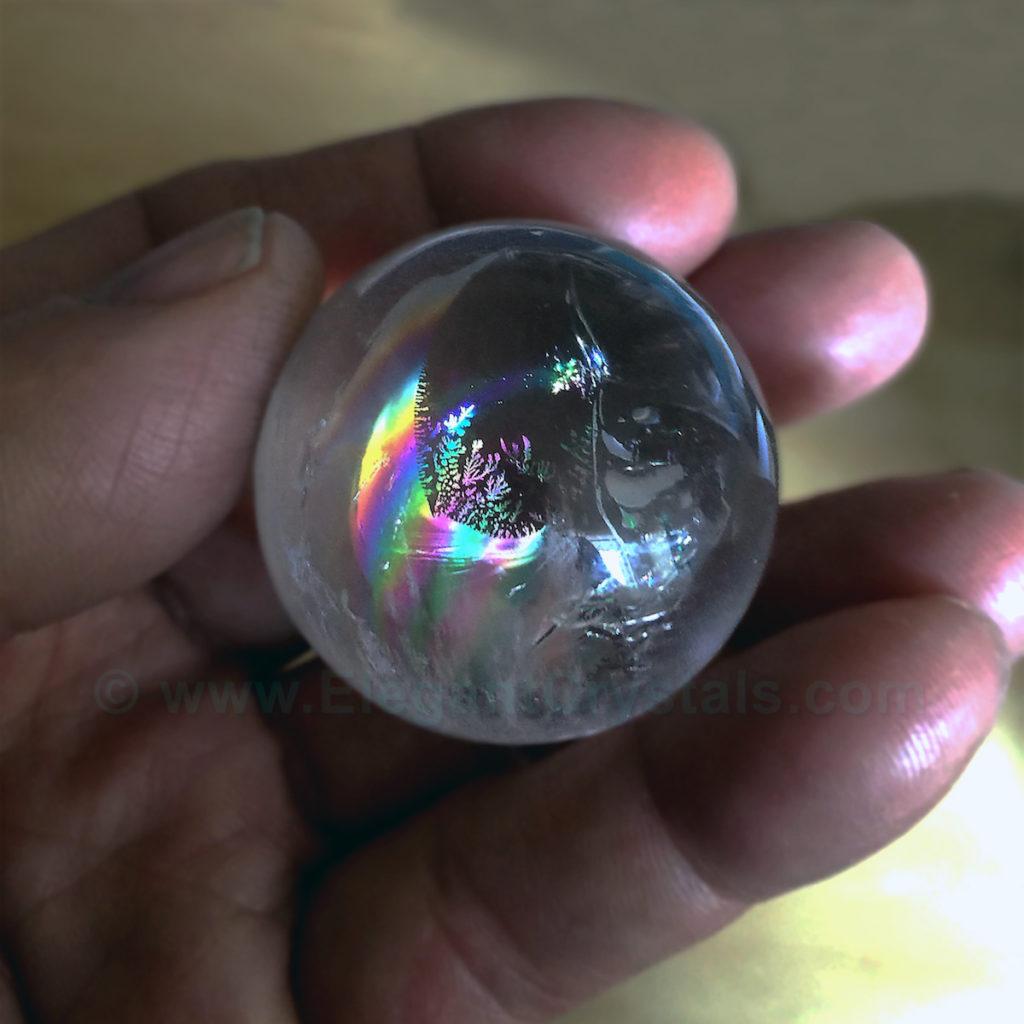
Picture #88
2-inch-wide Quartz Crystal Ball from Brazil
Why are crystal balls so attractive on so many levels?
The spheres with rainbows reach out and grab us with their ethereal beauty.
Many balls don’t have the vivid colors like the one shown here.
Still, even solid white quartz spheres have a lot going for them.
They are fun to hold, since they fit our hands so comfortably.
The solidity is comforting on several levels.
Touchstones of all kinds have been used as meditation aids and emotional support for eons.
The sphere shape gives us a stable point of focus in an ever-shifting, sometimes frightening, world of change.
The rocks (and rock crystals) represent solidity and eternity.
They were literally part of the ground under our feet; our support and stability.
In physical terms, the smoothness of quartz is extraordinary.
Polished quartz never looks dirty, and more importantly, never feels dirty.
The pristine appearance and smooth feeling of crystals represent purity on so many levels.
Crystal balls invoke perfection.

Picture #89
3-inch-wide Quartz Crystal Ball from Brazil
Quartz has the ability to absorb heat from your body as you hold a crystal or ball.
The tighter you squeeze it, the faster it warms up.
Sometimes they feel too hot to hold!
Once it warms up, you can use it as a wonderful massage stone.
You can even heat it up in warm water.
Try rubbing it on your forearms to loosen up tight muscles after a long day of typing.
Or tuck it under your shoulder blade while lying down, to get a great self-applied shoulder massage.
Two or three-inch globes work best for this purpose.
You’ll treat yourself to a physical massage and an energy treatment at the same time.
Here’s an interesting experiment.
Heat up the globe by squeezing it until it feels hotter than your skin.
Then touch it to your cheek or forehead.
Typically, the ball will feel cold.
What you experience as heat in your hand is actually enhanced energy levels from the quartz.
It may feel like heat, but when you switch the ball back to your other hand, it feels cool, then hot again as you switch it once more.
Congratulations!
You just had a crystal energy experience.
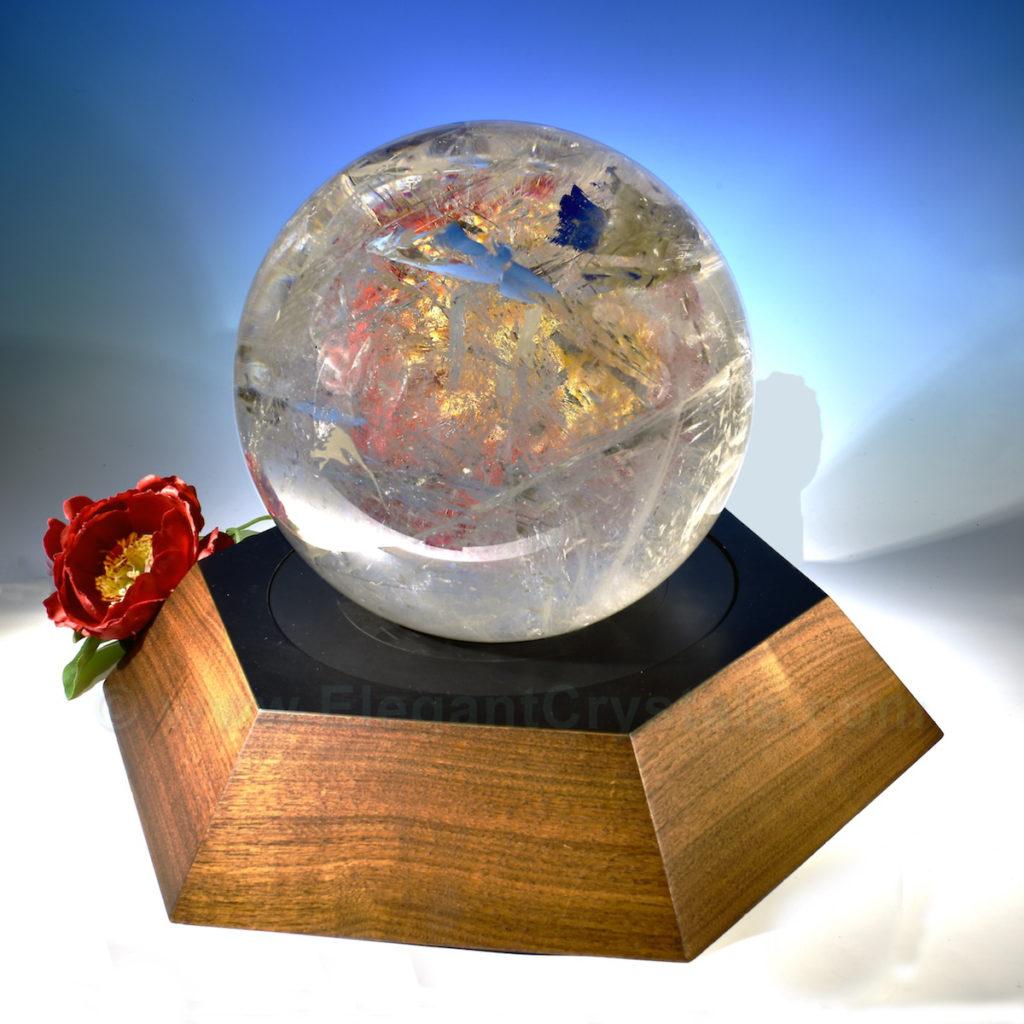
Picture #90
10-inch-wide Quartz Ball with Fissures from Brazil
What else attracts people to crystal balls?
The outer shape is lovely – so smooth, so perfectly round, so very planetary.
Since most spheres are amazingly round, it is easy to rotate them for a million different views.
Even large spheres, like the seventy-pound wonder shown here, are easy to spin.
Every viewing angle allows us to see the ball as a different tiny planet, as if we were observing it from outer space.
If you have a crystal ball on your altar, mantle or night stand, occasionally turn it around for an all-new view.
The variety is amazing.
The only exception is totally clear balls, which look the same from every angle.
Because of their extreme clarity, there is nothing to see inside them.
If you place something interesting behind it, you’ll see what’s in the background.
The transmitted image is always in focus and upside down.
Here’s another visual experiment to try.
Place a series of clear spheres behind one another in a line.
Use glass or acrylic balls for this, since water-clear quartz balls are expensive and hard to find.
The globes will transmit each other’s images in fascinating reflections.

Picture #91
6-inch-wide Flawless Brazilian Quartz Ball
The purity of quartz is the “gold standard” for clarity in the mineral kingdom.
Yes, diamonds are exceptionally clear, more so than quartz, but ever-so-much smaller.
The largest diamond ever found was about 4-inches-long.
It ended up much smaller after cutting and faceting.
I don’t know if anyone EVER cut a diamond sphere, since faceted stones sell for so much money.
Clarity is attractive, in itself and for what it represents.
Being “crystal clear” is a goal we can aspire to, mentally, emotionally and spiritually.
Here’s an internal exercise I often do in my meditations.
I study a clear ball and spend time memorizing what it looks like.
When I can visualize it in my imagination, I picture myself INSIDE the clear ball.
Then I see the interior of my body as crystal clear as this perfect globe.
I pretend my body is made out of the emptiness of outer space.
I fill myself up with twinkling stars and galaxies.
I become the Void and the Star Light.
It’s a wonderful, cosmic experience every time.
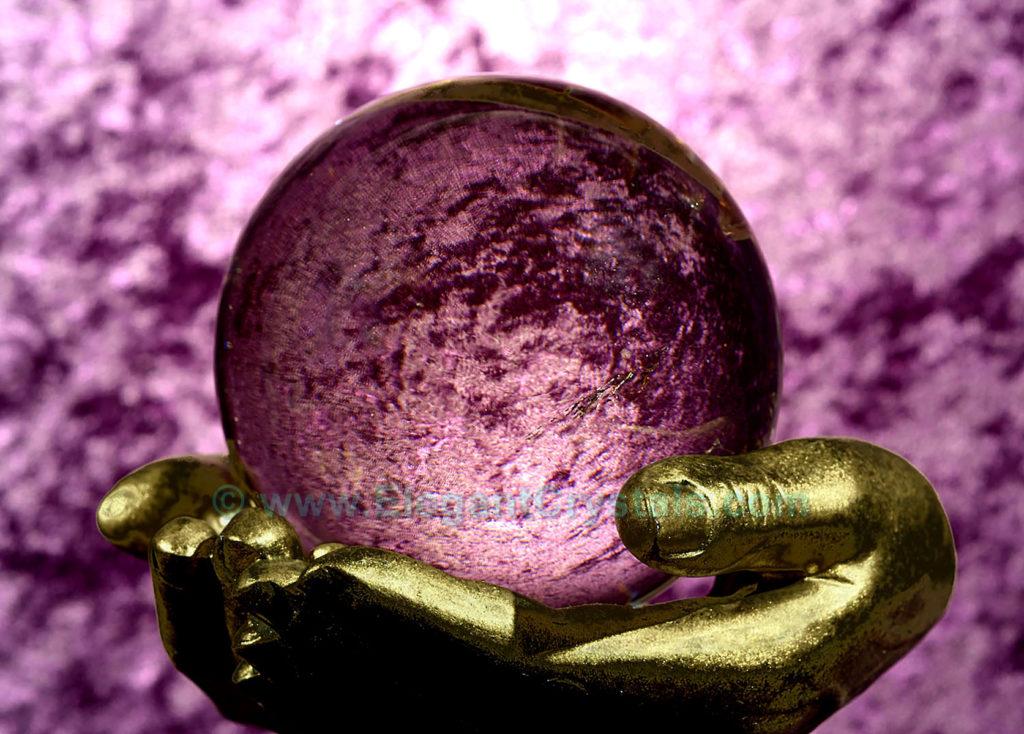
Picture #92
6-inch-wide, Nearly Flawless Quartz Ball from Brazil
In recent years, the demand for flawless quartz balls has skyrocketed.
It is now very difficult to get a perfect, natural quartz sphere over 1-inch-wide.
It’s hard to imagine, but if only 10% of the people on this planet collect crystals, there are 780 million people digging or buying stones right now.
If you include gemstones, minerals and stone carvings, then almost everyone in the world is a rock collector of some sort.
Each year, billions of people are sorting through billions of stone carvings, gems and crystals, looking for their favorites.
This is an enormous business.
Hundreds of millions of people are digging, washing, cutting, faceting and selling stones on Earth.
With this kind of competition, it’s no wonder that high quality stones are in short supply.
I haven’t seen a large flawless quartz ball in many years.
You could look at a million spheres, and maybe see one perfectly clear piece.
About 5 years ago, I heard of a perfect 4-inch-wide Russian quartz ball selling for $12,000 U.S. dollars.
At least the seller didn’t charge the buyer for sales tax.
I have exactly ONE perfect, optically clear quartz ball in my extensive collection.
It is a one-inch-wide, flawless globe, gifted to me by my crystal buddy, Mr. Qu, from China.
We work together to bring you the amazing rainbow pictures you see in this book.
He is my counterpart in China, a collector/researcher/dealer who is working, as I do, to bring you the most beautiful stones in the world.
I am indebted to him for all the work he has accomplished by sharing his amazing gems and crystals with the good people in China and the U.S.A.
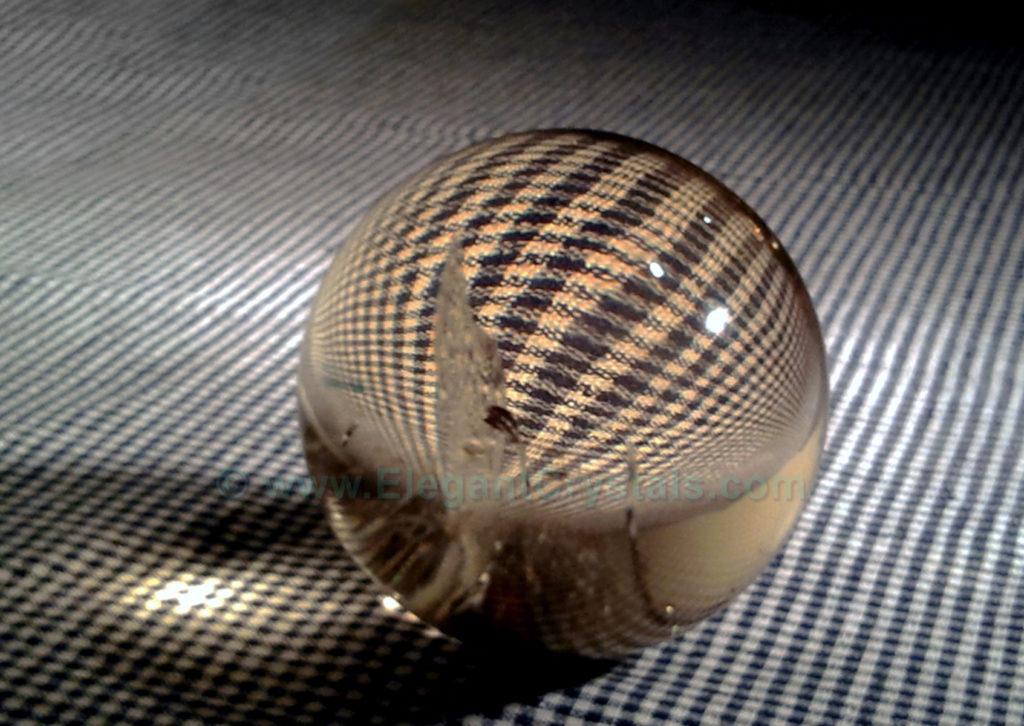
Picture #93
3-inch-wide Brazilian Quartz Sphere
When you buy a crystal ball, you can evaluate the amount of clarity by examining the background as seen through the ball.
Notice how the ball above has slight inclusions that block some visibility.
Also, the curvature of the ball magnifies the background as it distorts the straight lines and turns the image upside down.
I am a big fan of the wonderful, often colorful, mysterious inclusions in quartz.
Before we look at the various quartz inclusions, let’s figure out how to distinguish the many different types of clear spheres.
In nature, several minerals are fairly clear, and large enough to create a good-sized ball.
Calcite, selenite, even clear topaz, can be cut and polished into attractive, small, clear globes.
However, once you get over one-inch in diameter, only quartz can yield a large, perfectly transparent ball.
However, there are thousands, maybe millions of fake crystal balls available in stores and online.
What are they made of?
How do we distinguish them from “real” ancient quartz?
Plastic balls- Acrylic spheres are gorgeous and not hugely expensive. They weigh very little, so picking one up instantly discloses their synthetic nature.
These are easily scratched and dented, so handle with ultimate care.
You can’t clean them by rubbing them with anything.
Even invisible dust will scratch and blur the surface.
Wash them by rinsing with cool water,
and then gently pat them dry with a clean microfiber cloth.
Glass balls – these are traditionally used in chandeliers, gypsy readings, and paperweights.
They look great.
They are somewhat lighter than quartz, so, in theory, you could calculate their weight and volume, do a little math, and find out if the density is lower than quartz.
Glass balls are sometimes called “fused quartz.”
When quartz is fused (melted) it turns into glass, which is an
amorphous/non-crystalline substance.
“Fused quartz” is a misleading name, as all the piezo-electric quartz is gone- thoroughly melted into glass.
However, there is a much easier way to distinguish glass from quartz balls.
Place the ball on a magazine page or book with some letters on the page.
Look at the magnified text as you gently spin the ball.
If it is quartz, you will see a faint double image, a shadow that moves around each letter as the ball rotates.
At certain angles, the double image disappears; then it shows up again.
In glass, plastic or other substances, there is only one image.
The double image in quartz comes from a special property called double polarization or birefringence.
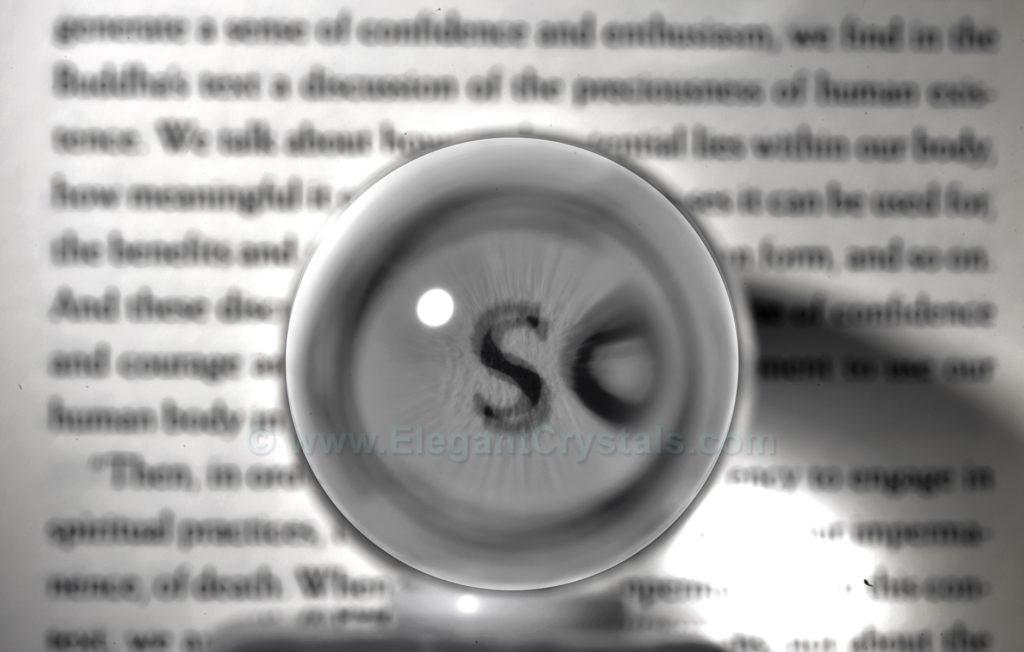
Picture #94
1-inch-wide Madagascar Quartz Ball Showing a Double Image
A special type of glass is called “leaded crystal” or “leaded glass.”
It is amazingly bright, clear and shiny due to the addition of the metal Lead.
Lead is normally dark gray, but turns water clear when melted into glass.
The leaded globes are heavier than quartz, softer and easier to scratch.
They only show one image when you test them for doubling on a page of text.
And now for the toughest challenge – distinguishing laboratory quartz from natural quartz (out-of-the-ground quartz.)
In a factory, scientists can create huge, perfect quartz crystals, which are visually and physically identical with natural quartz, when cut to the same size and shape.
These lab quartz balls have the same weight, density, appearance and electrical qualities as mined quartz.
So how can we distinguish the inexpensive lab crystals from the very expensive ancient quartz crystals?
First, look for inclusions.
Is the ball completely clear?
It still could be quartz that was mined and cut, but probably not.
If there is even one small inclusion characteristic of natural crystals, then it is likely the real thing.
It’s not a completely flawless sphere at that point, but pretty darn close.
Is there a line/plane down the middle of the crystal ball?
This is a “seed plane,” an artefact from laboratory growth.
This tells you the inexpensive ball came out of a factory process.
Is the price too low or too high? A low price indicates synthetic quartz, which WILL show a double image in the “text test.”
A high price might suggest rare natural quartz, or it could be a scam created by a greedy vendor.
I once found a great crystal ball in an antique store in San Francisco.
At 4 inches wide, and only $1,000, this would be a tremendously low price for a natural ball.
I checked it with the “text test,” and it turned out to be leaded glass.
I offered to teach the seller how to distinguish phony crystal balls, but she said she didn’t want to know!
She preferred to mislead her customers.
There is one way I can separate the real balls from the “faux-balls.”
Real quartz feels different in my hand.
The weight is the same – the size is the same – the smoothness is identical, but the subtle energy feels different.
The electrical charges in quartz create piezo-electricity.
This amazing quality allows quartz chips to function in many ways inside computers and scientific testing equipment.
The ancient natural crystals have a different energy charge from the blank “baby” crystals that come out of the laboratory.
The bottom line – natural flawless quartz spheres are so valuable that many people try to simulate them and charge too much money.
Protect yourself from scams with this knowledge, then develop the ability to FEEL the difference.
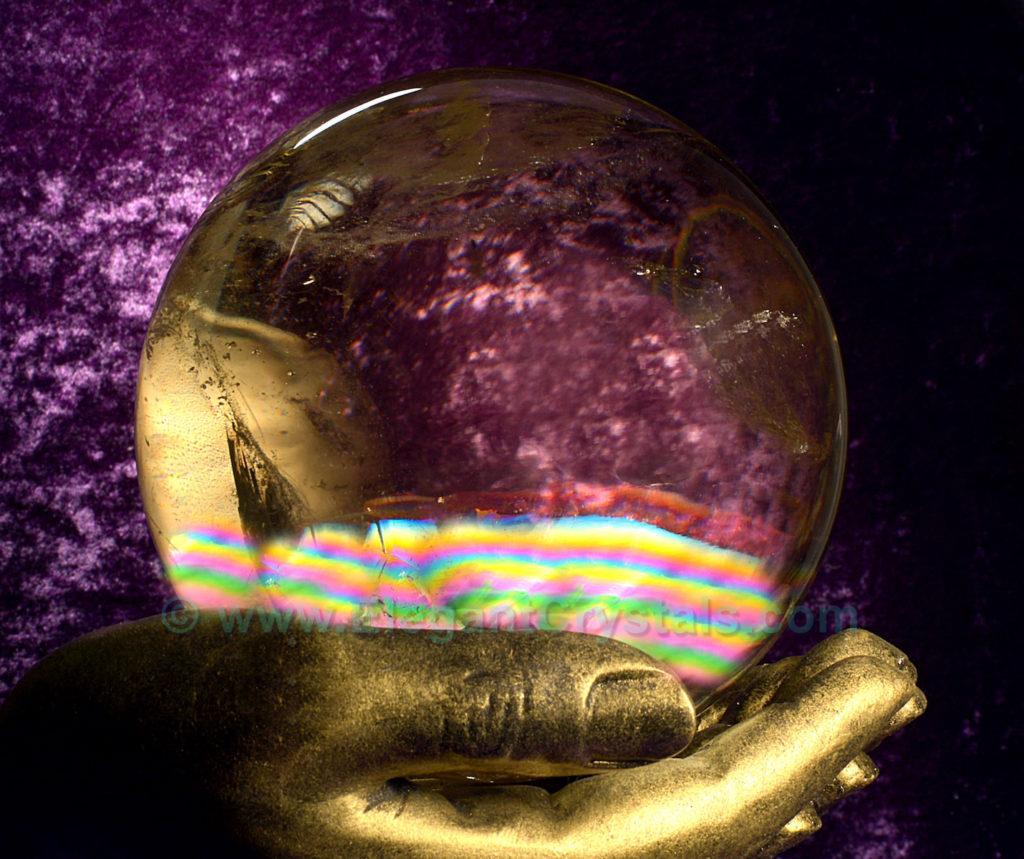
Picture #95
5-inch-wide Brazilian Citrine Quartz Globe
What other features make quartz so interesting?
The inside of a quartz ball typically combines 5 very attractive qualities:
Clarity, Mistiness, Rainbows, Sparkles and mineral inclusions.
Clarity ranges from totally opaque to a dense fog or light mist, interspersed with zones of amazingly clear material.
In all these situations, the ball will still transmit some light, and definitely glows when backlit.
Mistiness is caused by tiny drops or bubbles of water, liquids, gases or air trapped in the crystal structure.
The microbubbles often take the shape of waves or rivers of white foam inside the clear quartz.
If the bubbles are large enough, you can see water and air splashing around as an “enhydro” inclusion.
Sometimes the enhydro stone will also have tiny crystals floating in the liquid.
This is called a three-phase inclusion- liquid, solid, and gases.
Rainbows – The Iris Effect.
“Iris” is a synonym for rainbow, and also the name of the Greek Goddess of Rainbows.
They mean the same thing – an arc of changing, shimmering colors.
Quartz can have transparent colors throughout the crystal, such as the tones of amethyst or rose quartz.
It can also have colored particles inside the crystal caused by small trapped gems or layers of clay.
However, the iris effect is special, since the colors are an optical illusion, not created by a pigment of any kind.
The colors are not really there.
Think of the colors as a hologram – an illusion caused by light waves interacting with a zone in the crystal.
Like a rainbow in the sky, the quartz iris is a temporary effect, only seen at certain times and special angles.
When the quartz crystal is rotated, the rainbow will disappear and be replaced by a shimmery silver mirror, typically, with complex curved geometry.
The next 300 pictures are all different kinds of iris patterns and colors.
Quartz rainbows are the heart of this book, the heart of my collection and they are most dear to my own heart.
I consider myself a Rainbow:ologist.
Sparkles
Twinkly light is so attractive, wherever it occurs.
The thrill of fireworks, the charm of the sun or moon reflecting on ocean waves, the delight of Christmas tree bulbs gleaming, the stars in the night sky – everyone is fascinated by glimmers of light.
Sparkles in quartz have many sources – tiny cracks, encapsulated little gems or crystals, interfaces between multiple crystals, even little bubbles.
They all make the crystal lively, especially when surrounded by transparent zones of clear material.
Layers of clay or gems are intriguing not only for their vast range of colors, but also for the intricate shapes that occur as flat “phantom” planes, and as “gardens” of multicolored clay.
These are occasionally formed by garnets, pyrites, or flecks of pure gold or silver wires.
Any substance trapped in the quartz is preserved for eternity.
Some of the quartz crystals are over 600 million years old.

Picture #96
Stone Spheres from around the World.
Another fascinating quality of crystals, and quartzes in particular, is their ability to evoke emotions and visions that allow us to explore the depths and heights of our being.
The quartz acts like a mirror for our deepest nature.
Quartz can be a gateway or portal that some sensitive psychics can use to peer into the past, the future, or parts of the world in present time.
The crystal ball becomes a lens to see virtually anywhere with our inner vision/third eye/pineal gland.
You can use the distinctive electrical energy of quartz crystals and crystal balls to sensitize your own electrical nerve system.
You might receive messages from any part of the Universe, or from previously hidden parts of yourself.
Create your own cosmic mirror by working with the subtle energies of quartz.
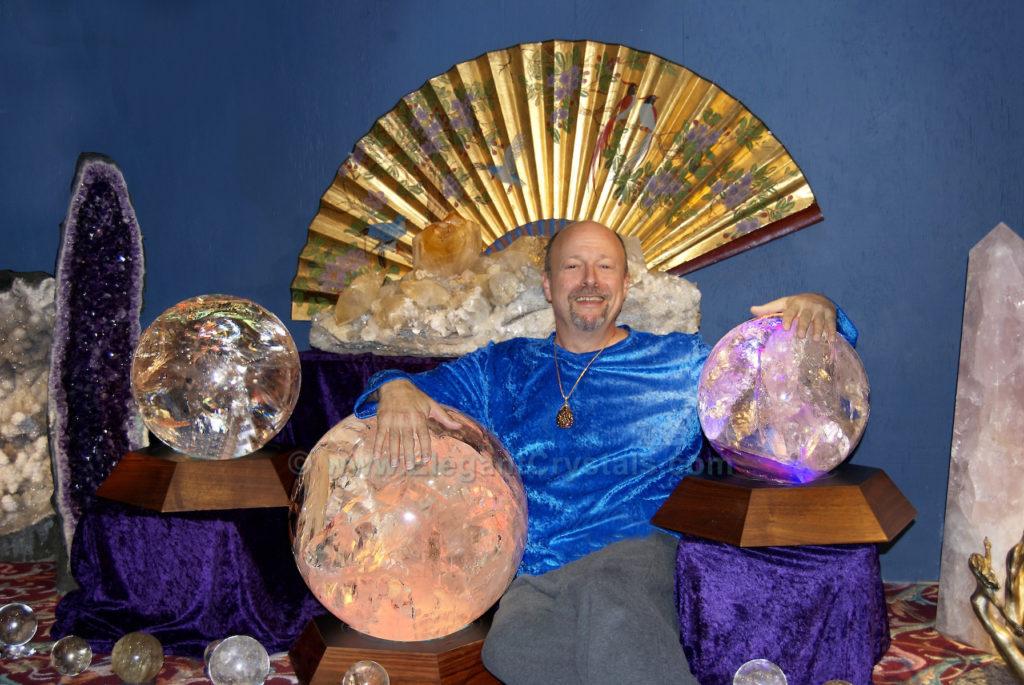
Picture #97
Crystal Bill with Pet Rockstm in Mill Valley, California, 2009
Photo by Celestine Star
Every year, a few huge crystal balls are cut and polished in Brazil.
I have been fortunate to buy and sell a dozen huge balls over the last 40 years.
I always look for the ones with the best rainbows.
I feel extraordinarily blessed to spend some time with these ancient treasures.
I sold all three of these giant globes to the same collector.
My buyer then sold one ball back to me, which I ended up selling two more times!
Life is strange sometimes.
Crystal balls can be created up to one or two meters wide.
The largest ones are usually milky, almost opaque, and don’t show rainbows.
I tend to skip those, as they are often too murky for my tastes.

Picture #98
Fire Damage from a Crystal Ball- An Important Warning for You
Crystal balls are powerful on many levels.
This cardboard box contained a dozen small crystal spheres.
Even though I knew better, I accidentally allowed a ray of sunshine to fall on one clear ball.
The globe acted as a magnifying lens that concentrated the heat of the sun onto the cardboard box.
Fortunately, I smelled the first wisps of smoke, and covered up the box just before a fire could break out.
Clear spheres, whether quartz, glass or plastic can start fires instantly.
Please heed this caution and respect the power of the stone.
I have had four close calls where quartz balls almost started fires by scorching furniture.
One of them tried to burn through the dashboard of my car.
That globe wasn’t even very clear.
Another one was a large faceted clear geodesic shape.
My sensitive nose repeatedly saved my house, and maybe my life, from fire.
The larger the ball, the hotter the fire.
Never, I repeat, NEVER leave a clear ball in a sunny window!
The ball can create a thousand degrees of heat in less than a minute.
If you carry a clear ball in the palm of your hand when you walk outside in bright sunshine, you WILL burn your hand and drop the ball reflexively.
The benefits of quartz balls are so amazing and extensive that I consider the fire risk to be a minor preventable side effect.

Picture #99
2-inch-wide Madagascar Quartz Ball
Most quartz crystals are not perfectly clear.
Endless types of “inclusions” add variety and mystery to the viewing of crystals.
What is the best way to see these interesting patterns?
Ideally, the crystal will have a smooth, clear outer surface and zones of pristine clarity inside.
Many natural crystals have slick surfaces when they arise from the ground.
Others have to be polished to see inside.
Flat facets can show great interior landscapes.
However, the view inside will be complicated by nearby facets, which reflect and refract light into confusing double images.
Curved surfaces can also distort visibility inside the orb.
Spherical surfaces will distort everything inside by magnifying, instead of warping, the images.
You can still get a nice clear look at the inclusions when the ball turns.
A crystal ball acts like a lens, focusing light for a great view inside.
Think of the sphere as a high-quality wide-angle camera lens.
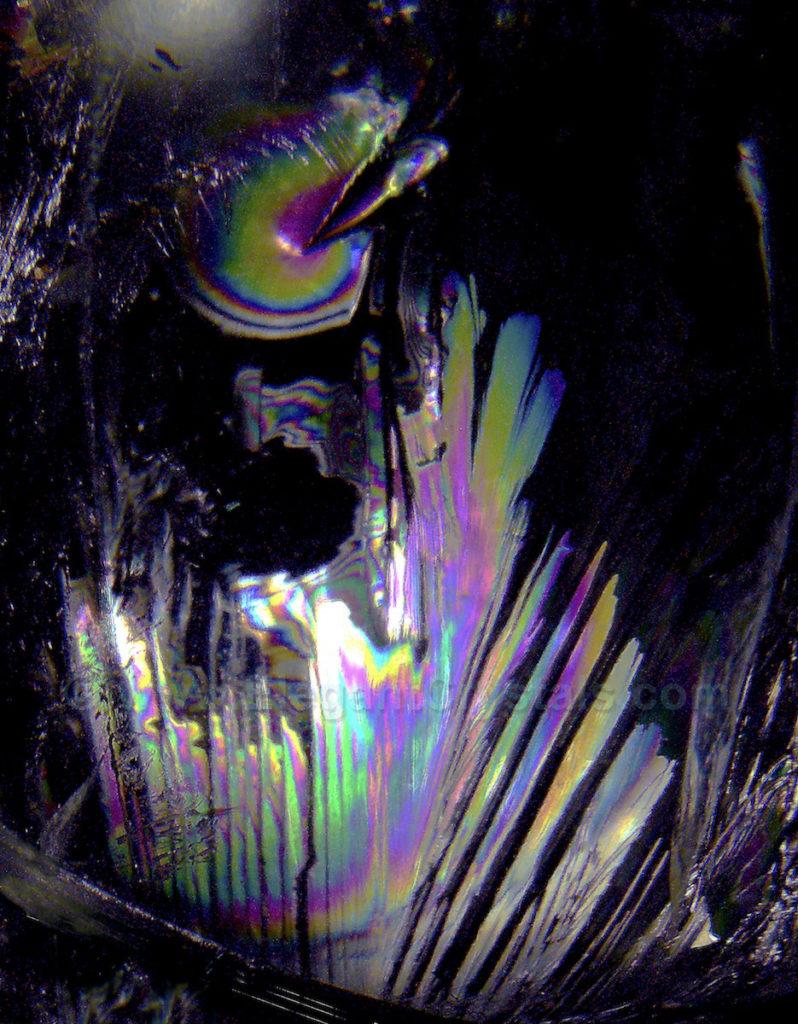
Picture #100
Closeup Image of a 2-inch-wide Madagascar Quartz Ball
Inside the crystal, multiple gaps in the quartz
look like silvery mirrors or crumpled tin foil.
These areas create the colored light of the iris effect at certain angles.
What should we call these gaps?
Is it
a break,
a crack
a fissure
a discontinuity
a flaw
a fracture
a crevice
a cleft or
an opening?
Some of these words have emotionally loaded meanings; implying damage was done at some point.
Let’s take a closer look at what is going on.

Picture #101
4-inch-wide Madagascar Quartz Ball
on a Golden Hand Sculpture,
in Front of a Picture of the Same Ball
I like the terms “discontinuities or gaps” to describe the silvery areas in quartz.
For the longest time, I felt these magic mirrors were breakage caused by any number of scenarios.
If a crystal is dropped on a very hard surface, like rocks or concrete, it can definitely break.
This causes distinctive patterns that do NOT look like these gaps.
We will examine these later, in the chapter on Conchoidal Rainbow Fractures.
Did the crystal break in the ground while it was still growing and forming?
Heat and pressure variations in the crystal cave can often cause cracks.
Earthquakes can also damage a crystal.
The pressure waves alone can affect the structures, or a crystal might fall off the cave wall and hit another stone.
This last situation is unlikely to break the interior of a crystal.
The crystal will fall in VERY slow motion due to the enormous density of the growth fluid, basically molten rock, known as magma.
Whatever the cause of the gap, it may be a sudden event, causing a distinct cracked pattern.
I think the situation is ultimately much more complex, as even tiny gaps can expand over time as the crystal grows larger.
The discontinuities may start out small, even microscopic sizes, and then grow larger, along with the crystal.
As they get bigger, the gaps are also crystallizing at the edges into flat shapes and geometrical patterns.
In a sense, the crystal’s atomic structure is programming the shape of the fissure, as well as its potential color range.
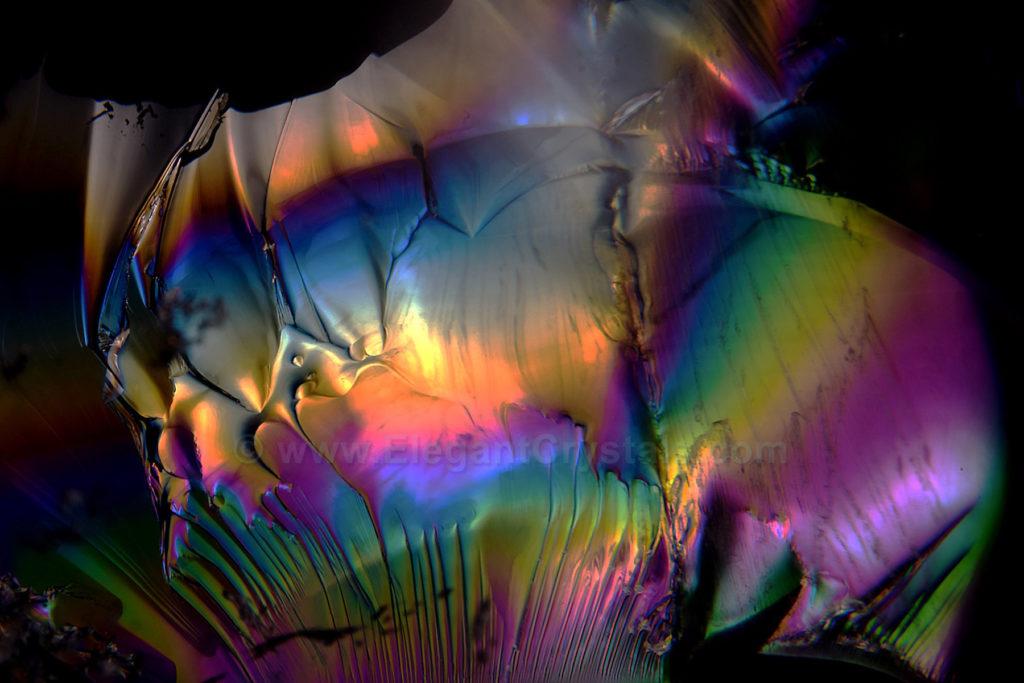
Picture #102
Closeup Photo of the Previous Madagascar Quartz Ball
There is nothing random about the colored patterns in quartz.
An amazing variety of shapes can occur in crystals that are similar to many other forms found in nature:
Rivers and streams
Mountains and valleys
Trees, flowers and ferns
Branches and roots
Nerves and blood vessels
What do all these configurations have in common?
The flowing patterns are naturally expansive progressions, not defects in the object.
The designs tend to take on branching forms called “dendritic” formations.
A “dendrite” is a mineralogical term that references similarities to branch, root and veined leaf shapes.
You can see similar patterns in pictures taken from outer space that show how mountains and rivers split and divide again.
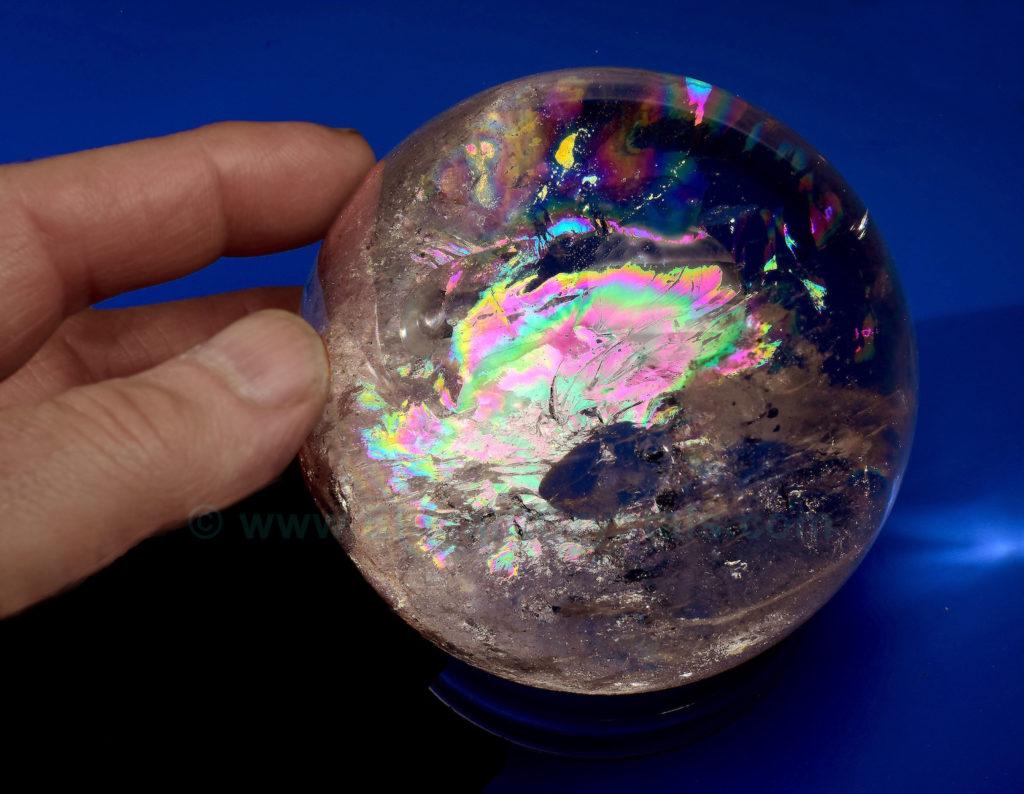
Picture #103
3.5-inch-wide Madagascar Quartz Ball
Song of the Sphere
by Cikira
I took up a gemstone,
Admired every side,
And asked for its story.
The cold orb replied:
I’m a quartz crystal,
I grew in the earth.
Scars on my innocence
Measure my worth.
Fissures and phantoms,
Needles and mist,
I am a planet
The size of your fist.
You cut and ground me,
Polished me smooth,
Chasing reflections
And rainbows and Truth.
Ponder vibrations!
Turn me in hand!
Scrying no angels?
I well understand!
For I am imperfect,
Both fractured and true.
I’m a quartz crystal;
I’m just like you.
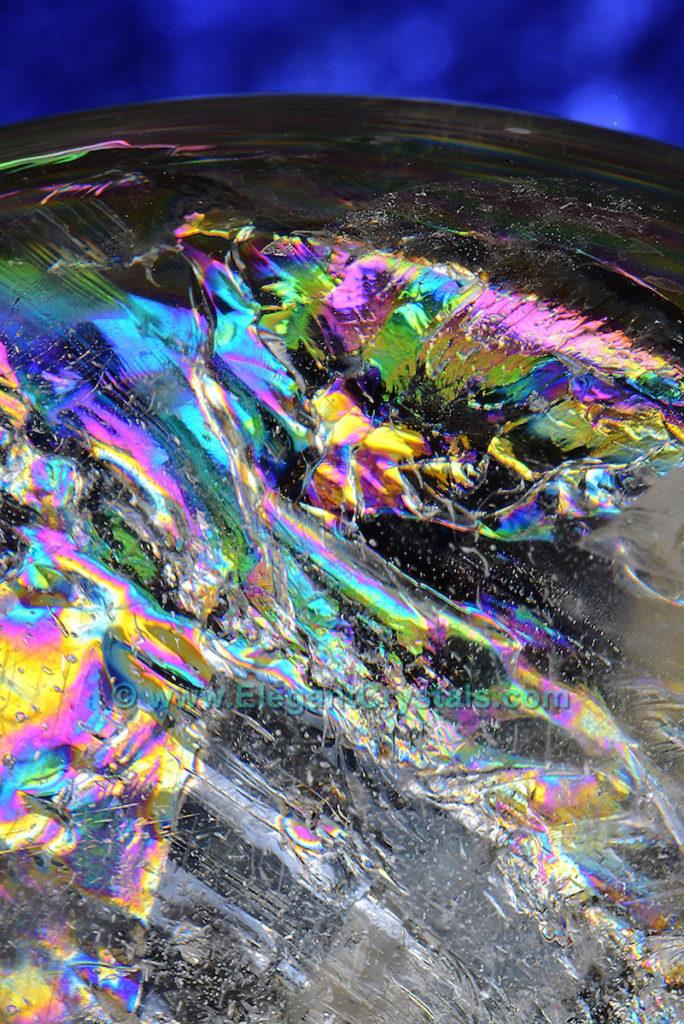
Picture #104
Closeup Photo of a 6-inch-wide Brazilian Quartz Ball
How would it feel to hold a tiny planet in your hand, a world of mystery and magic?
Crystal gazers used quartz and glass balls for many centuries past, to explore the mysteries of the universe.
Is the crystal a window to your soul?
Is it a lens peering into the future?
What can we learn from these ancient teaching stones?
“Scrying” is the process of opening up the mind and heart to receive subtle impressions transmitted on a psychic level.
This is not a repeatable, scientific process.
It will probably never be subject to experimental laboratory confirmation.
Indeed, James Randi, The Amazing Randi, has offered a one-million-dollar prize to anyone who can fully demonstrate a repeatable psychic ability.
No one has successfully claimed the prize over the last few decades.
Still, millions of people believe in mental powers such as telepathy (mind to mind communication);
prognostication (seeing or hearing future events);
and psychometry
(receiving information about a person by holding her personal belongings.)
There is a huge variety of special powers claimed by talented psychics.
Clever magicians can fake them all. So, what is true or not true?
That is a personal decision based on your experience.
I personally have witnessed the following many times:
Knowing who is calling me before I pick up the phone.
(This ability was more impressive before caller ID became so widely used.)
Having a dozen dreams come true based on later events.
Finding 22 crystals at rock shows over a period of 25 years, after dreaming about those specific crystals.
When I wake up, I always draw pictures of the distinctive crystals that appear in my dreams.
Then I can compare the dream image to the actual rocks I find.
I have watched five people recover almost instantly from serious illnesses and injuries, where crystal energy was used to dissolve and deactivate bacteria, viruses and inflammation.
I have even had two doors unlock themselves with no human assistance, during emergencies.
This is called telekinesis: moving objects with the power of the mind.
Have you ever had an unexplainable event in your life?
These subtle experiences can be life-saving or life-changing.
Crystals help these powers and abilities come into focus.
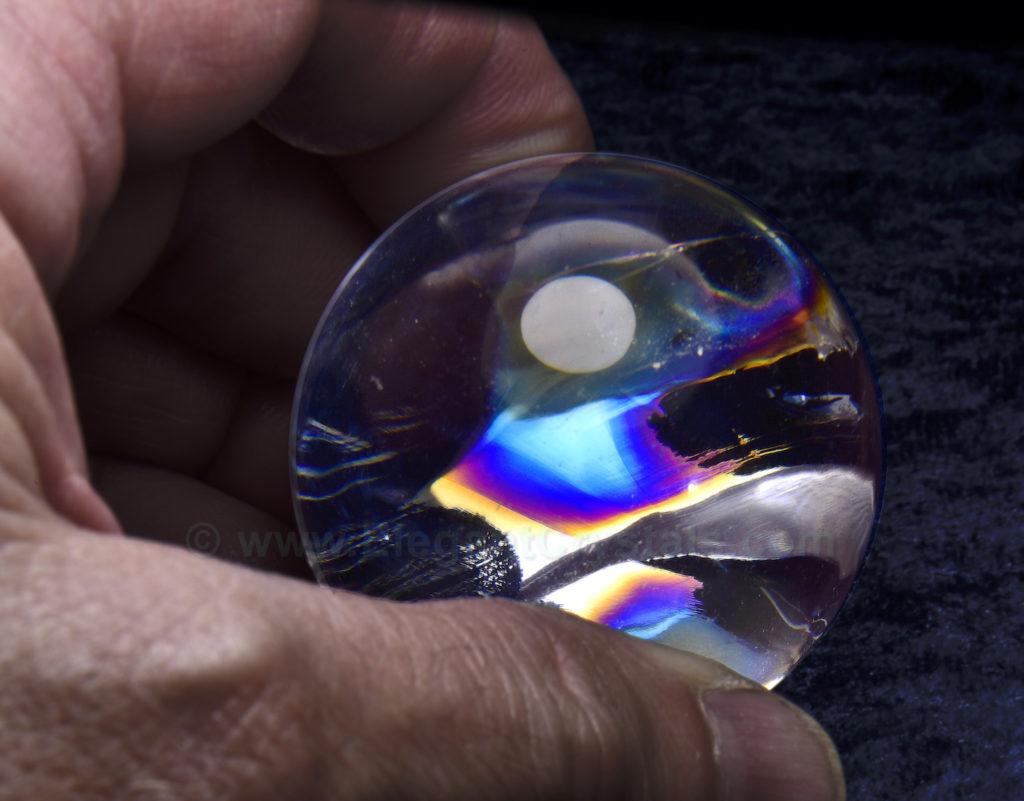
Picture #105
2-inch-wide Madagascar Quartz Ball
The Gazer’s Way
by Cikira
It’s dark behind my eyelids
And the universe is wide;
O Mother Moon, pray lead me to
A world to step inside.
The polished orbs their puzzle pose:
I must seize one alone
To mine for magic mirrors
Floating frozen in the stone.
For She who lives in every time
And reigns in every place
At one celestial lodge will pause
To meet me face to face.
I hover with my fingertips,
I listen with my skin;
I strain an artless inner eye
For one that glows within.
Her choice is hard to reckon
By intuition’s light.
O Mother Moon, impart to me
The knack to do it right!
“Child, so it is with people
And the reading of their hearts.
There is an ancient lesson in
The essence of the quartz.”
She said, “Just let your spirit hum.
Await an answering call,
And harmony will draw you to
The ready gazing ball.”
So may I greet all vibrant orbs
Of bone or mineral hewn!
For endless mingling energies,
I thank thee, Mother Moon.
